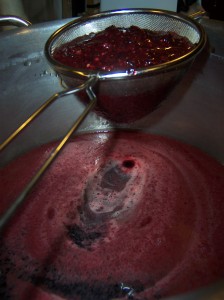I’ve wanted to make a pyment for a while now. Pyment is simply one of the fancy names for mead variants (such as melomel, metheglin, cyser, etc) that refers to mead made with grape juice. I was going to do a pyment last season, but never did — apparently I was distracted by the plethora of choice ingredients available for mead at this time of year when grapes are ripe in this climate. However this year, after a phone call from a friend alerting me to a patch of wild Concord Grapes, I finally had a good chance to do so.
Concord Grapes (Vitis labrusca) were developed nearby (in Concord, MA) in the mid-19th century:
Experimenting with seeds from some of the native species, Boston-born Ephraim Wales Bull developed the Concord grape in 1849. On his farm outside Concord, down the road from the Emerson, Thoreau, Hawthorne and Alcott homesteads, he planted some 22,000 seedlings in all, before he had produced the ideal grape. Early ripening, to escape the killing northern frosts, but with a rich, full-bodied flavor, the hardy Concord grape thrives where European cuttings had failed to survive. In 1853, Mr. Bull felt ready to put the first bunches of his Concord grapes before the public — and won first prize at the Boston horticultural Society exhibition. From these early arbors, fame of Mr. Bull’s (“the father of the Concord grapeâ€) Concord grape spread world-wide, bringing him up to $1,000 a cutting, but he died a relatively poor man. The inscription on his tombstone states, “He sowed–others reaped.â€
These grapes are hardy, and can be found in abundance in New England, having been cultivated here for many decades. Indeed, it sometimes seems that the grapes outlast the abandoned human settlements where they were first planted. I found a patch in an urban setting, and harvested about 2 quarts:

The grapes have seeds in them of course, and while there is a bit of sweetness to them, the overwhelming flavor is tartness/sourness. It will be a nice counterbalance to the sweet honey. After harvesting, I blended the grapes in the blender, and then strained them into the 2 gallon chaga decoction I had made previously:

I then added about 14 cups of honey, enough to get me up to a 17% alcohol potential:

Normally with meads, one must add various acids (citric and tannic), but grapes contain both of these, so I just went simple: chaga decoction, spring water, honey, and grapes. The result is a beautifully rich colored brew:

I look forward to this one! I have only tried a few pyments, and really want to explore this further. Now I’ll have a chance!
UPDATE 7 Jan
This one is fruity and beautiful. It is sweet at 4% remaining alcohol potential, and is 13% alcohol.

One thought on “Chaga Pyment”
Comments are closed.